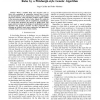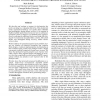19 search results - page 1 / 4 » Redundant Modeling for the QuasiGroup Completion Problem |
CP
2003
Springer
13 years 10 months ago
2003
Springer
Abstract. The Quasigroup Completion Problem (QCP) is a very challenging benchmark among combinatorial problems, and the focus of much recent interest in the area of constraint prog...
FUZZIEEE
2007
IEEE
13 years 6 months ago
2007
IEEE
When a flexible fuzzy rule structure such as those with antecedent in conjunctive normal form is used, the interpretability of the obtained fuzzy model is significantly improved. H...
GECCO
2003
Springer
13 years 10 months ago
2003
Springer
A robust structural damage detection method that can handle noisy frequency response function information is discussed. The inherent unstructured nature of damage detection problem...
ASPLOS
1992
ACM
13 years 9 months ago
1992
ACM
We describe and evaluate a strategy for declustering the parity encoding in a redundant disk array. This declustered parity organization balances cost against data reliability and...
PODS
1993
ACM
13 years 9 months ago
1993
ACM
In this paper we consider the problem of using disk blocks efficiently in searching graphs that are too large to fit in internal memory. Our model allows a vertex to be represented...


